Introduction
South Korea boasts an incredibly affordable and efficient public transportation system, making it easy to get around without a car—especially in major cities.
But whether you’re visiting South Korea for a short time or settling in long-term, having the ability to drive can completely change your experience. It lets you explore hidden corners of the country, venture beyond tourist hotspots, and travel at your own pace—no more waiting for buses or squeezing into packed subways.
That said, you might be wondering:
👉 Can foreigners rent and drive a car in South Korea?
👉 What are the rules, and is it difficult to navigate?
I get it—driving in a foreign country where you don’t know the laws (or the language) can feel intimidating. But don’t worry—it’s a lot easier than you think, and if you’re confident behind the wheel, you’ll have no problem adapting.
I say this from experience. I recently took a ski trip to Hokkaido, Japan, where I rented a car and had to switch to driving on the left side of the road—in the snow, no less.
Between the car’s built-in navigation system and the English text on road signs, getting around was a breeze. If I could pull that off, you’ll be just fine in South Korea, where the roads are well-marked, and traffic laws are easy to follow.
I also know this because I’ve lived in South Korea since 2007. For over a decade, I got by just fine without a car, relying entirely on public transportation. But during the early COVID years, when international travel was off the table, I finally decided to take the plunge.
With some extra cash saved from canceled trips, I exchanged my U.S. driver’s license, bought a used car, and hit the road—and I haven’t looked back since.
Now, I’m here to walk you through everything you need to know about renting and driving in South Korea as a foreigner. Whether you’re just looking for a short-term rental or considering buying your own car, this guide will cover it all.
Quick heads up: This post may contain affiliate links to gear, hotels, flights, or experiences I’ve used — or genuinely recommend. If you book through one, I may earn a commission at no extra cost to you. Full disclosure here.
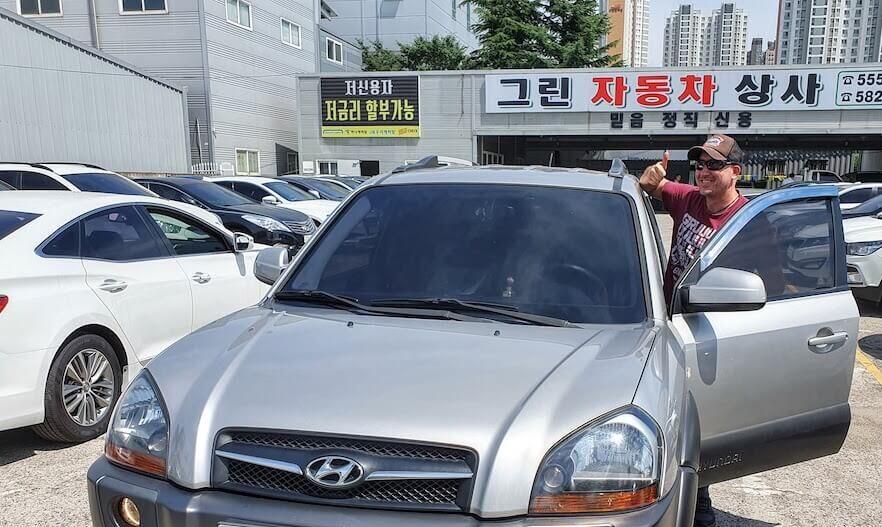
How to Rent a Vehicle in South Korea
Renting a car in South Korea is straightforward as long as you meet the necessary requirements (which we’ll cover below).
If you’re fluent in Korean or have a local to assist you, SoCar is a popular car-sharing app that many Koreans use. It’s super convenient—you can even have the car delivered to your hotel or home.
Before we bought our own car, my wife used SoCar for several road trips, and while she had no issues, I’ll be honest—I’d struggle to navigate the app on my own.
For most travelers, the easiest way to rent a car in South Korea is through DiscoverCars. It’s an international platform that lets you compare rental agencies, find the best deals, and book with ease—just like you would back home.
As an affiliate partner of DiscoverCars, I may earn a commission at no extra cost to you.
Eligibility
To rent a car in South Korea, you’ll need to meet the following requirements:
- Age Requirement: You must be at least 21 years old. However, for luxury cars, SUVs, or vans, some rental companies may require drivers to be 26 or older.
- Driving Experience: Most rental agencies require at least one year of driving experience.
- Valid Driver’s License: You must have one of the following:
- International Driving Permit (IDP): Must be issued by a country under the Geneva or Vienna Convention and valid during your rental period. Chinese, Taiwanese, and Indonesian IDPs are not accepted in South Korea.
- Korean Driver’s License: If you hold a local license.
- USFK (United States Forces Korea) Driver’s License: Available for U.S. military personnel stationed in Korea.
Types of Insurance
Understanding rental car insurance is essential to avoid unexpected costs. Here are the main types of coverage available in South Korea:
- Mandatory Liability Insurance: This is the minimum required by law, covering injuries and property damage to third parties.
- Comprehensive Insurance: Optional coverage that protects against damage to your own vehicle, reducing your financial responsibility in case of an accident.
- Driver’s Insurance: Additional coverage that provides compensation for the driver’s medical expenses, fines, and legal fees in case of an accident.
Claim Process
If you’re involved in an accident while driving a rental car, follow these steps to ensure a smooth claims process:
Gather Required Documents:
- Claim Form (available from your rental company, often in English).
- Insurance Certificate (proof of your coverage).
- Identification (passport or alien registration card, if applicable).
- Police Report (filed at the scene).
- Car Registration Documents (kept in the vehicle).
- Driver’s License (must be valid).
Contact Your Rental Agency and Insurance Provider: Report the accident immediately and follow their instructions.
Document the Scene: Take clear photos of the accident, vehicle damage, and surrounding road conditions.
Seek Medical Attention if Necessary: Even minor injuries should be checked by a doctor.
Remember to review the rental agency’s terms and conditions thoroughly.
Driver’s License Requirements for Foreigners in South Korea
To legally drive in South Korea as a foreigner, understanding the driver’s license requirements is crucial—unless you want to star in one of those foreign prison shows on Netflix.
I’m joking. I think.
Short-Term Visitors (Tourists & Temporary Stays)
If you’re visiting South Korea as a tourist or short-term traveler, you can legally drive with an International Driving Permit (IDP) for up to one year.
I actually picked one up in Korea before my trip to Japan—it was super easy, took about 10 minutes, and cost me roughly $9 at the Korean version of the DMV.
This means you don’t need a Korean license to rent a car in South Korea, but you do need an IDP. So, if you’re planning a trip and want to drive, I highly recommend securing an IDP from your home country before you leave. You can get one while abroad, but let’s be honest—it’s probably much easier from the comfort of your own country.
Long-Term Foreign Korea Residents
If you’re a long-term resident (like yours truly), you’ll need to get a South Korean driver’s license.
Luckily, this process isn’t overly complicated. In most cases, you can exchange your foreign driver’s license for a Korean one. I say “most cases” because this only applies to people from recognized countries that South Korea allows license exchanges with.
If you’re from Oregon or Idaho, bad news—you’ll need to take a written test for some reason. I went to college in Oregon and most of my family now lives in Idaho, so I guess I dodged that bullet as I’m officially a Colorado resident with no U.S. residence anymore.
To exchange your license, you’ll need to submit:
✅ Your valid foreign driver’s license
✅ A certified Korean translation of your license
✅ Required paperwork to your local driver’s license examination office
Now, about that Korean translation—I won’t lie, I barely remember what I did for this part (I’ve had my Korean license for over four years now). But I do recall it being kind of a pain in the butt.
If you’re an American, the U.S. Embassy provides instructions on their website. If you’re from another country, you’ll likely need to contact your country’s embassy in Seoul for translation requirements. It’s a bit of a hassle, but hey—if you’ve made it this far, you might as well see it through.
If You Don’t Have a Valid License from Your Home Country
If you never had a driver’s license in your home country (or yours has expired), you’ll need to go through the same process as a Korean citizen to obtain a license.
This means:
🚗 Taking a written exam (available in English!)
🚗 Passing a driving test at your local licensing office
I don’t have personal experience with this, but I do know that some instructors speak basic English, and you might have to take the test a couple of times (just like back home!).
Since I had a valid Colorado driver’s license, I went the easy route—license exchange. The only test I had to take was an eye exam at the DMV (which, by the way, is not to be confused with the DMZ—you don’t want to mix those up).
The whole process was pretty straightforward, and honestly, I’m still a little surprised I’m legally allowed to drive around South Korea without fully comprehending all the laws of the road.
But let’s just keep that between you and me.
What Happens When You Exchange Your Driver’s License in South Korea
Something that is important to note is that when I say I exchanged my Colorado driver’s license for a Korean license, they actually took my Colorado license away from me and filed it away in a little box!
I’m not sure why, in this day and age, a digital scan or a photocopy doesn’t suffice, but you should expect to be without your home country’s driver’s license for awhile.
You can, however, go back and re-exchange your licenses, but please be aware that DMV workers are a unique breed of pencil-pushing antagonists who may try to aggravate you just for sport, no matter what country you are in.
The first time I returned home to Colorado, rightfully wanting to have my American ID with me, I had to go to battle with the Dwight Schrute of the Daegu DMV.

The article that I linked above states that you can simply return to the Korean DMV office when you’re leaving and present them with a flight itinerary proving that you are leaving, and they’ll happily give you your license back.
Not so fast. My Korean Dwight informed me that the printed flight itinerary I presented was not the required e-ticket and refused to give me my license back.
He wasn’t going to budge with logic or sweet talk.
What in the heck is an e-ticket, you may ask? To this day, I still don’t know. It’s apparently something that some Korean airlines issue.
I, however, was flying on Delta, which had been booked on Expedia. Thus, I arrived armed with my printed Expedia itinerary and receipt.
I also had a Delta phone app that showed my ticket, my reservation number, my seat assignment, and any other information that any sane individual would take as proof that I would be ‘leaving on jet plane‘ the following day.
I was not dealing with a sane individual, however, and we battled it out for roughly 3 hours over whether or not I was trying to pull the scam of the century by trying to get my own driver’s license back.
My wife was on the phone in tears. I had reached the point of flagrantly throwing English profanity around carelessly, and Dwight’s co-workers were starting to take notice.
Finally, after one of these co-workers assured him that my documents were actually in line with “policy“, he ultimately shoved both my American and Korean driver’s licenses under the little window and implored me ‘to never come back‘.
That was one promise I was happy to keep, especially since I now have both licenses firmly in my possession.
The Korean license is valid for 10 years, so hopefully either Dwight or myself will have moved on by then!
Driving in South Korea: What You Need to Know
When driving in South Korea, you should follow the laws just as you would anywhere else.
Generally speaking, the rules of the road align with international standards.
In South Korea, you drive on the right-hand side (as in left vs. right, not right vs. wrong). If you’re coming from Japan, where they drive on the left, or from Hong Kong/Macau, where they also drive on the left but China drives on the right—yeah, it can be confusing.
Seat belts are mandatory for all passengers, and the legal blood alcohol limit is just 0.03%—which is extremely low compared to many countries.
One thing to note about law enforcement in Korea: cameras and citizen reporting handle much of the work when it comes to traffic violations. But when it comes to drunk driving, the police don’t mess around. Roadside checkpoints are common, and getting a DUI in a foreign country is definitely not worth the hassle.
Breaking traffic laws can result in fines, license suspensions, or even deportation—so drive smart.
Speed Limits in South Korea
Like most countries, speed limits vary depending on the type of road.
🚗 110 km/h (100 km/h in urban areas) – Expressways
🚗 80 km/h – Multi-lane roads
🚗 60 km/h – Single-lane roads
🚗 50 km/h – Urban & rural roads
🚗 30 km/h – Residential areas
Note: Speed and distance are measured in kilometers, not miles. If you’re American, get ready for your navigation system telling you to turn left in 78 meters.
School Zones: Slow Down or Pay Up
School zones in Korea are always marked at 30 km/h (18 mph) and almost always have speed cameras.
I learned this the hard way after moving to a new house. I unknowingly drove through a school zone on my way to work every day, only to receive about 10 speeding tickets ($30–$50 each) in the mail before I figured out what was happening.
If you’re renting a car in Jeju Island, be aware that school zones with cameras are everywhere—but this applies to all of Korea. They sneak up on you fast.
Do You Need to Know Korean to Read Road Signs?
Not really. Most directional road signs are in both Korean and English, so navigation isn’t difficult.
The only major exception? Stop signs in Korea don’t have the English word “STOP” written on them—but if you don’t know what a stop sign looks like, you probably shouldn’t be driving anyway.
That said, learning how to read Hangul (the Korean alphabet) will help a lot, especially for smaller signs or local information.
Let’s be honest, though—your navigation app is going to do most of the heavy lifting anyway. Just find one you’re comfortable using, and you’ll be fine.
What to Do in Case of an Accident in South Korea
🚨 If you’re involved in a car accident in Korea, follow these steps:
1️⃣ Stop Immediately – If you caused the accident, you must stop, even if there are no visible injuries.
2️⃣ Check for Injuries & Assist – Help anyone who is injured.
3️⃣ Exchange Information – Share your name, phone number, and insurance details with the other party.
4️⃣ Gather Evidence – Take photos and get witness contact info if possible.
5️⃣ Seek Medical Attention – Even if injuries seem minor, it’s best to get checked within 48 hours.
6️⃣ Report the Accident – Call the police at 112 and notify your insurance company.
My advice, first and foremost, is to drive overly cautiously and to avoid getting into an accident at all costs.
A Word of Caution About Accidents in Korea
Here’s where things get tricky: You’re not supposed to move your vehicle after an accident.
Yep, you read that right. Even if your cars are blocking traffic, you’re expected to leave them exactly where the accident happened until authorities arrive. You’ll then take photos, discuss fault, and sort things out on the spot.
Even if you speak some Korean, you probably won’t have the upper hand in the discussion—so it’s best to be cautious and avoid accidents at all costs.
The good news? Most cars in Korea have black box cameras, which can help prove who was at fault.
South Korea isn’t overly litigious, but small injuries can suddenly turn into major hospital visits when money is involved. If you ever find yourself in a complicated situation, seek legal advice or have a Korean-speaking friend on hand to help you navigate the process.
My wife just went through this process and there is a choreographed song and dance that Koreans go through with hospital visits to maximize insurance payouts.
South Korea Driving Tips & Common Annoyances
I considered devoting an entire section to my many driving grievances, but if I’m honest, most of them are just the usual city driving frustrations that exist anywhere in the world.
I grew up in a laid-back Colorado ski town with no stoplights and a general sense of mutual respect on the road. That attitude doesn’t exist in reality anymore—especially in major cities—where it’s more of a “survival of the fittest” approach to driving.
That said, there are a few quirks and frustrations unique to driving in South Korea that you should be aware of.
I’ll admit—this might get a little “old man yelling at clouds.”
1. 초보 (Cho Bo) Drivers – Beginner Driver Stickers
Many cars in Korea have a “초보” (Cho Bo) sticker on the back window, meaning the driver is a beginner. In theory, this is helpful, signaling to other drivers to be cautious. In practice? See the next point.
2. Inconsistent Driving Speeds
Very few drivers in Korea actually follow the posted speed limits. Instead, they seem to fall into two extremes:
🚗 Wannabe F1 drivers flying down the highway at reckless speeds.
🚗 Cautious crawlers driving 20 km/h under the speed limit.
There is very little in between, which can make for some nerve-wracking highway moments.
3. The Hazard Light Excuse (a.k.a. Hazardous Parking)
This one drives me the craziest. On major 2- or 3-lane roads, it’s completely normal for people to block an entire lane by parking with their hazard lights on.
Why? It could be grabbing coffee, picking up a friend, or just sitting there—but somehow, hazard lights seem to be the universal signal for “I know I’m doing something wrong, but I’m immune because I pressed this button.”
This isn’t just an annoyance—it’s dangerous. And yet, it doesn’t seem to be policed at all.
4. Narrow Side Streets
A lot of Korean side streets and neighborhood roads allow street parking, meaning they can feel very tight.
I’m not complaining about this one—just exercise patience, let other cars pass, and trust that it usually works itself out.
Mastering the Art of Parking in South Korea
Whatever gripes I have about driving in Korea, I’ve got to applaud their parking skills.
Since many residential streets are crowded with street parking, Korean drivers have mastered the fine art of squeezing into impossibly tight spaces.
Thinking of Buying a Car? Consider the Size
If you’re planning to buy a car in Korea, be aware that most parking spaces—even in lots—are much narrower than in countries like the U.S..
For example, in Idaho, where my family lives, nearly everyone drives the biggest truck imaginable. That wouldn’t fly here.
In Korea, cars are packed bumper to bumper, and yet, people seem to have perfected the art of getting in and out without dinging doors. It’s a fine art, but it works.
There’s an episode of The Simpsons where Bart, as a prank, paints all the school parking spaces one foot closer together.
That’s basically what parking in Korea feels like.
Why Do Koreans Always Back Into Parking Spots?
Ever had a hill you’re willing to die on, even though you know you’re probably wrong?
This is mine.
In South Korea, backing into parking spots is practically a national sport. Nearly everyone does it, and if you walk through a parking lot, 95% of cars will be neatly reversed into their spots.
Maybe it’s just how I was raised, but I refuse to back in. To me, it takes extra effort, skill, and patience—all things I lack when parking.
I once casually mentioned this on TikTok, and the internet quickly informed me that backing in is “the correct way” to park. So be it. I’m too old to change.
But if you ever find yourself in a Costco parking lot in Daegu and spot the only front-end parked car, stop by and say hello.
The Perks of Exploring South Korea by Car
South Korea has an excellent public transportation system, but no train or bus will ever give you the freedom, flexibility, and adventure potential of having your own wheels.
I’m not here to sell you a car, but I can tell you how mine has completely changed my experience in Korea.
Dog-Friendly Travel 🐶
I mentioned earlier that I bought my car early in the pandemic. Around that time, I also adopted a border collie named Winnie.
No one has benefited more from my car ownership than her.
She’s been on near-daily adventures—to mountains, beaches, swimming pools, and dog-friendly cafés in the most random, off-the-grid places.
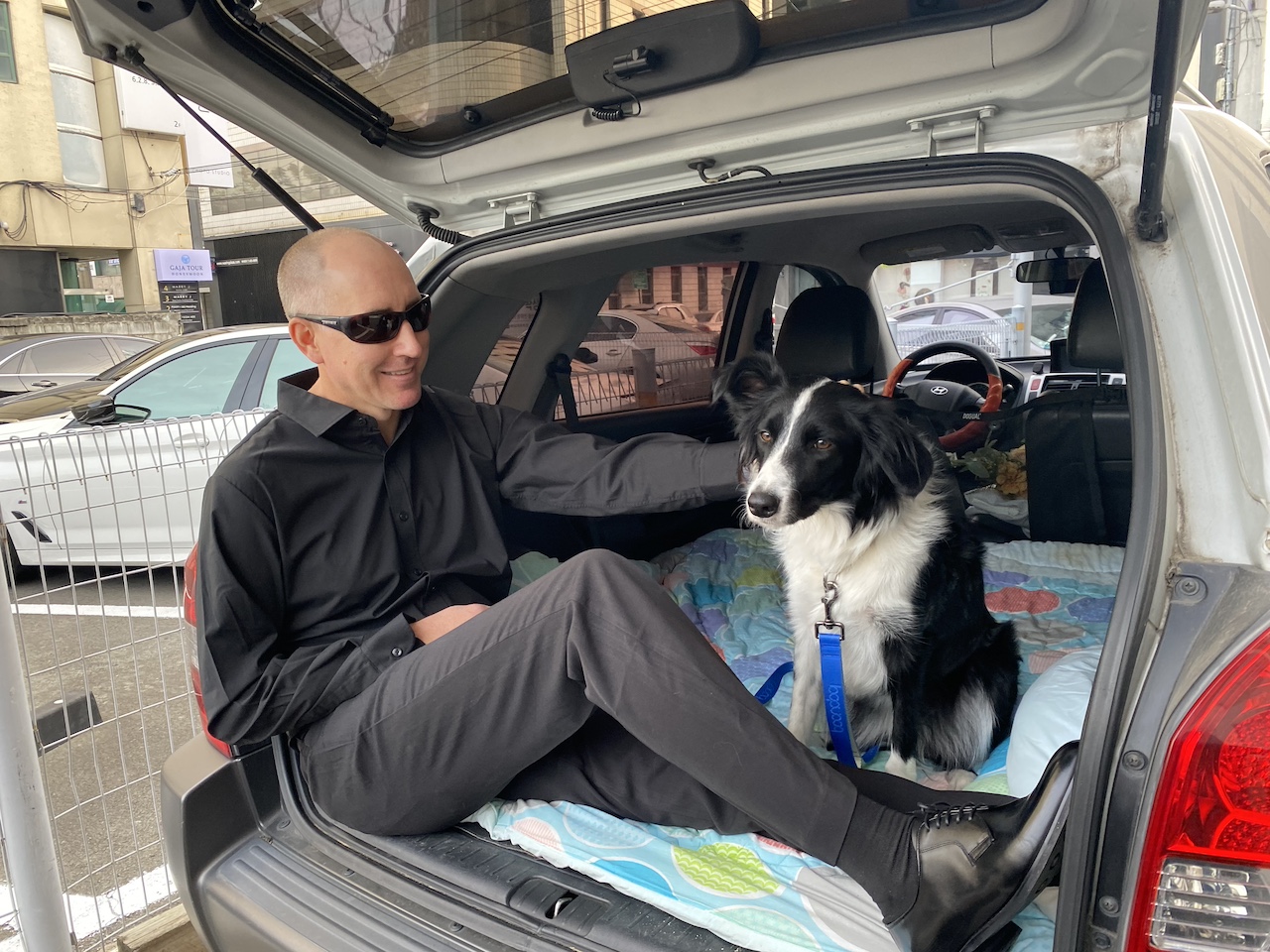
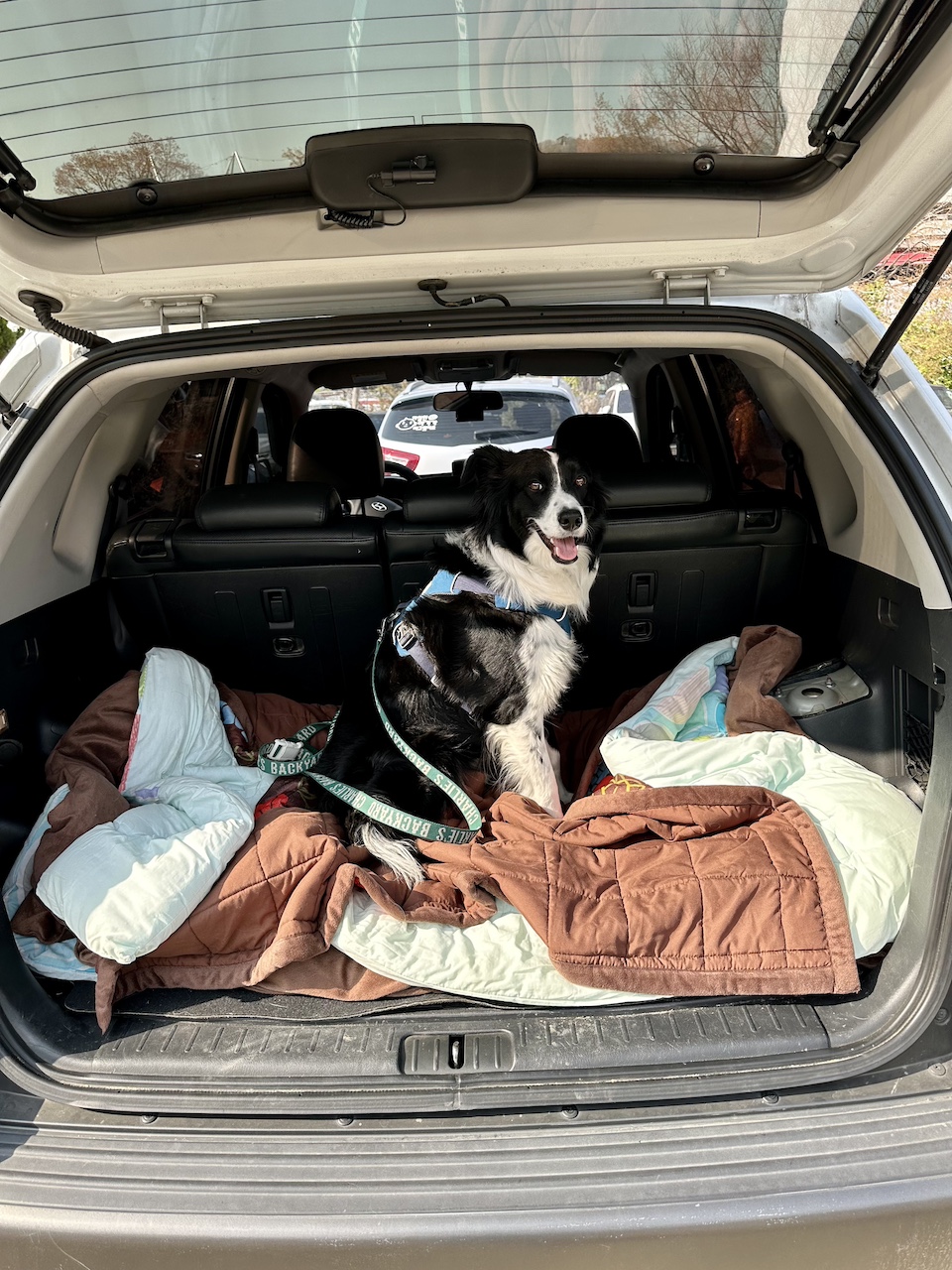
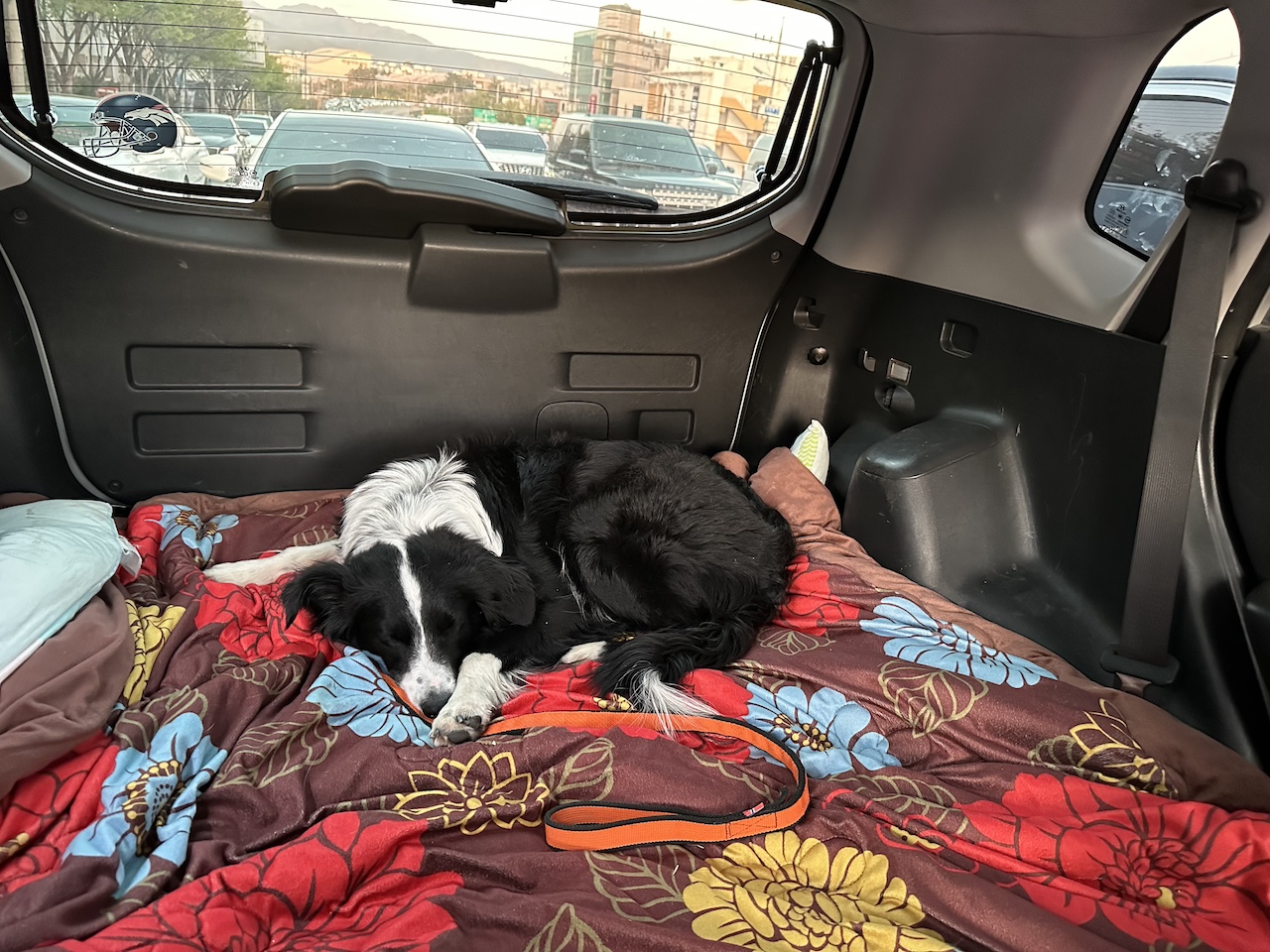
This dog is living her best life and goes on near-daily adventures to mountains, beaches, swimming pools, and dog-friendly cafés in rural areas.
She has been to Jeju Island twice, which I wrote about in Exploring Jeju Island: A 5-Day Dog-Friendly Adventure and Smooth Sailing: An In-Depth Guide to Jeju Island Ferry Travel.
And speaking of dog-friendly cafés, Korea has an entire subculture of hidden cafés just for dog owners. My wife always seems to find them, and they’re nowhere near the typical tourist routes.
Which brings me to my next point…
Getting Off the Beaten Path
Trains and buses will take you to Korea’s major destinations—places like Itaewon, Hongdae, or Haeundae Beach. And if you’re visiting, you absolutely shouldn’t miss them.
But I’ve been here a long time. I’ve done the big tourist spots. These days, I want to explore the countryside, hike in the mountains, and find hidden gems that public transportation just doesn’t reach.
And for that, a car is a game-changer.

Hitting the Slopes: Skiing & Winter Road Trips in Korea
One of the biggest ways owning a car has improved my life in Korea? Ski season.
Let’s be real—Korea isn’t exactly a world-class ski destination, but if you live here or are visiting in winter, skiing is a blast.
Back when I first moved to Korea, I was skiing 100+ days a season in Colorado. Then suddenly, entire ski seasons passed without me even touching my skis—mostly because skiing in Korea usually requires signing up for a ski package.
These packages are great for beginners or casual skiers, but after doing a few early on, the novelty wore off. I missed the freedom of driving to the slopes whenever I wanted.
That changed when I bought my car.
Last season alone, we took three ski road trips, and I finally reignited my love for skiing. I’m still not back to my 100-day seasons in Vail, but hitting the slopes in Korea on my own schedule has been a game-changer.
🚗 Ski trips now look like this:
- Load up the car the night before.
- Wake up, grab coffee, and drive straight to the mountain.
- Skip the crowds, ski all day, and be back home that night (or stay overnight if we feel like it).
I also got to watch my wife take up skiing for the first time, going from nervous beginner to full-speed, reckless abandon in a single season.
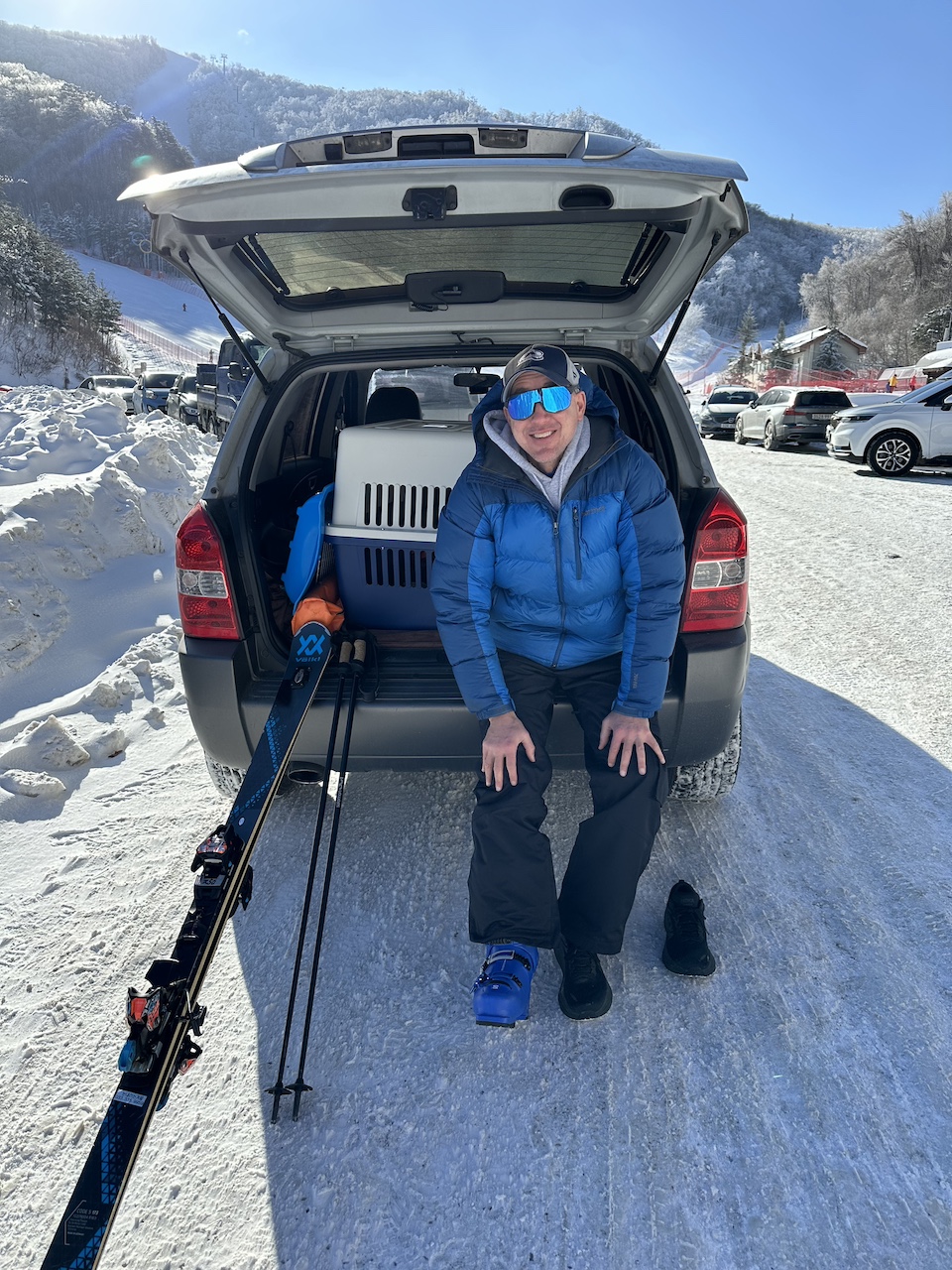

Final Thoughts: Driving in South Korea
Driving in South Korea is an incredible way to explore the country—whether it’s escaping the city for a weekend in the mountains, cruising along coastal highways, or discovering hidden cafés and countryside gems.
That said, it comes with its own unique challenges. Traffic, creative parking strategies, and unexpected speed cameras can take some getting used to. But with a little patience (and a good navigation app), you’ll be fine.
🚗 Thinking about renting a car in Korea?
- If you’re just visiting, get an International Driving Permit (IDP) before you arrive.
- If you’re living here long-term, exchanging your foreign license is a straightforward process.
- Drive defensively, be aware of school zones & traffic cameras, and don’t trust hazard lights to mean anything logical.
For me, owning a car has been a game-changer. Whether it’s taking my dog Winnie on adventures, heading to the slopes for a last-minute ski trip, or just avoiding crowded public transportation, having my own wheels has given me the freedom to explore Korea on my terms.
Wherever the road takes you—drive safe and enjoy the ride!
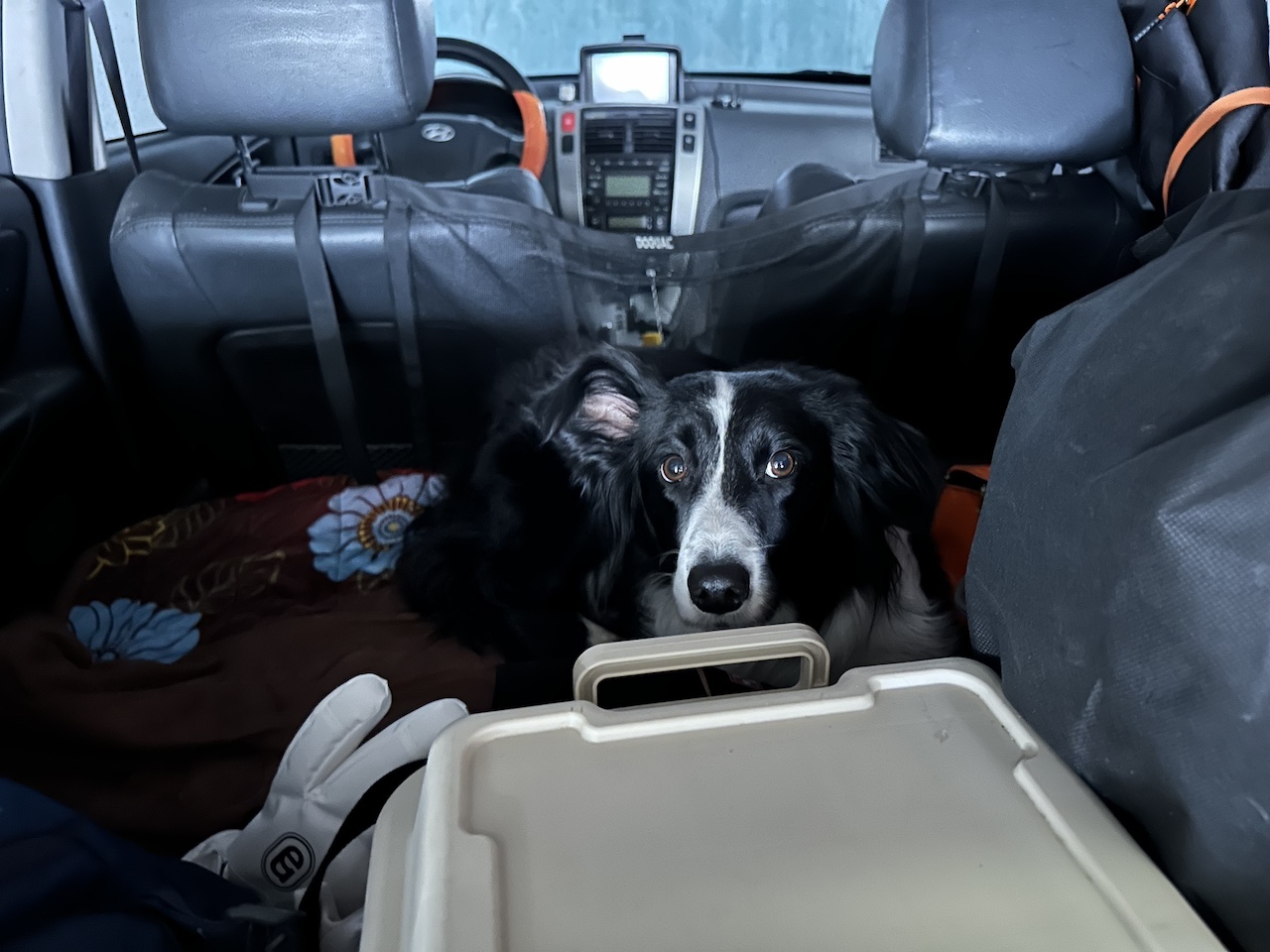
FAQs: Renting & Driving in South Korea
If you have questions, please join my free Facebook group and community. I’m happy to answer you there!
Can foreigners drive in South Korea?
Yes! Short-term visitors can drive with an International Driving Permit (IDP) for up to one year. Long-term residents can exchange their foreign license for a Korean driver’s license.
Do I need an International Driving Permit (IDP) to rent a car in Korea?
Yes, if you’re visiting South Korea, most car rental agencies require an IDP. Make sure to get one before you arrive, as you can’t apply for it within Korea.
What side of the road do they drive on in Korea?
Koreans drive on the right side of the road, just like in the U.S. and mainland Europe.
What are the speed limits in South Korea?
110 km/h (68 mph) – Expressways
80 km/h (50 mph) – Multi-lane roads
60 km/h (37 mph) – Single-lane roads
50 km/h (31 mph) – Urban & rural roads
30 km/h (18 mph) – Residential areas & school zones (with speed cameras everywhere!)
Are road signs in Korea in English?
Yes! Most major road signs have both Korean and English. However, stop signs only have the Korean word 정지 (jeongji)—but they look exactly like stop signs everywhere else.
Is it hard to find parking in Korea?
In cities – Expect tight spaces & creative parking techniques (like hazard-light parking).
In the countryside – Parking is much easier.
Are traffic laws strictly enforced in Korea?
Yes and no. While speeding & traffic violations are mostly enforced by cameras, DUI laws are very strict, and roadside sobriety checkpoints are common.
Is it expensive to rent a car in Korea?
Car rental prices vary, but you can usually find a compact car for $40–$80 per day. If you’re visiting during peak seasons (summer & ski season), book in advance to get the best rates.
What’s the best way to rent a car in Korea?
I recommend using DiscoverCars to compare rental agencies, find the best deals, and book online before you arrive.


